Patricia Highsmash
Examining New X-Men Pt 4-2
by Travis Hedge Coke
From 2001 to 2004 Grant Morrison (The Invisibles, Batman and Robin) and team of pencilers, inkers, letterers, editors and colorists, including Phil Jimenez, Mike Marts, and Frank Quitely made a comic called New X-Men.
Revitalizing the X-Men as a politically savvy, fashion forward superhero soap opera, New X-Men was published by Marvel Comics as the flagship of a line wide revival.

Morrison, Leinil Francis Yu, Gerry Alanguilan
[Continued from last week, an exploration of the physical, sexual, and psychic nature of New X-Men characters.]
Bodies, Sexualities, and Souls (Pt 2)
Xorn
Xorn’s existence is considered by other characters almost exclusively as either a physical or psychical condition, indicative in their choice of their comfort and their predilections.

Grant Morrison, Bill Sienkiewicz, John Paul Leon
Seeing the mask hiding his thoughts as if they were pure and unharmful thoughts, the psychically-inclined assign Xorn a class of troubled, traumatized children on the assumption he will be patient and kind with them. Those students, pubescent, discovering their changing bodies and biochemistries, perceive Xorn in a physiological context. Is the teenagers who asked how he eats, where he defecates, and who reposit his excuse for going away by himself of meditation, as masturbation.

Grant Morrison, Tim Townsend, Frank Quitely
New X-Men expands on the X-Men tradition of disguises and untruths, to encompass a new realm psychic disguises, of deceptive minds, even predatory minds, and while Xorn’s is achieved through tools, rather than genetic mutation, it is no less unquestioned by the likes of Xavier or Grey, or Cyclops who is afraid of both the tangible effects of thoughts and the biological condition of physical life.
The limits as to what is confirmable about Xorn, is what allows other characters and audience to make it up based on their personal bias.
Quentin Quire
Teenaged frat fascist, Quentin Quire, redesigns his entire visual aesthetic, causes a school-wide riot, beats his headmaster with a baseball bat, and causes deaths, incarcerations, and ICU visits, all in the name of sexual conquest.

Grant Morrison, Frank Quitely, Tim Townsend
Quire, his mental powers growing at a ferocious rate, invigorated by rampant abuse of the drug, kick, is taxing his physical body beyond its capacity, in the hopes of impressing one of the Stepford Cuckoos, a set of identical siblings.
Quire’s mutant powers will be treated differently, post-New X-Men, but under Morrison, he has incredible telepathic gifts, including being subtly and intensely persuasive, and his own mind is “see-thru.” Quintin Quire’s thoughts are not opaque, in the way that Xorn’s seem to be, but invisible, or at the very least as transparent as the alien from the Predator movies.
Quire’s heterosexual jealousy throws him immediately into confrontation with men or boys he deems challengers for top position in the eyes of girls and women, he perceives girls and women as prizes implied as reward for obtaining top position.
Quire shows disdain for mutant without psychic abilities, disdain for women in general even under the guise of praise, disdain for men who do not immediately fall to subjugation for him, disdain for the adoptive parents who raised him, and fines inspirational solace it ain’t made up caricature a presumed dead genocidal demagogue, Magneto, who ultimately will reveal himself to Quire immediately before murdering him.

Frank Quitely, Grant Morrison, Chris Chuckry
Quire socially and emotionally destroys the boyfriend, Slick, a fellow student Tattoo, exerting his persuasive powers over her so that she is sexually attentive as well as joining his violent gang, a super-powered sexual assault that is part of his plot to impress, and thereby receive sexual favors, from the Cuckoo he is attracted to.
Sabretooth
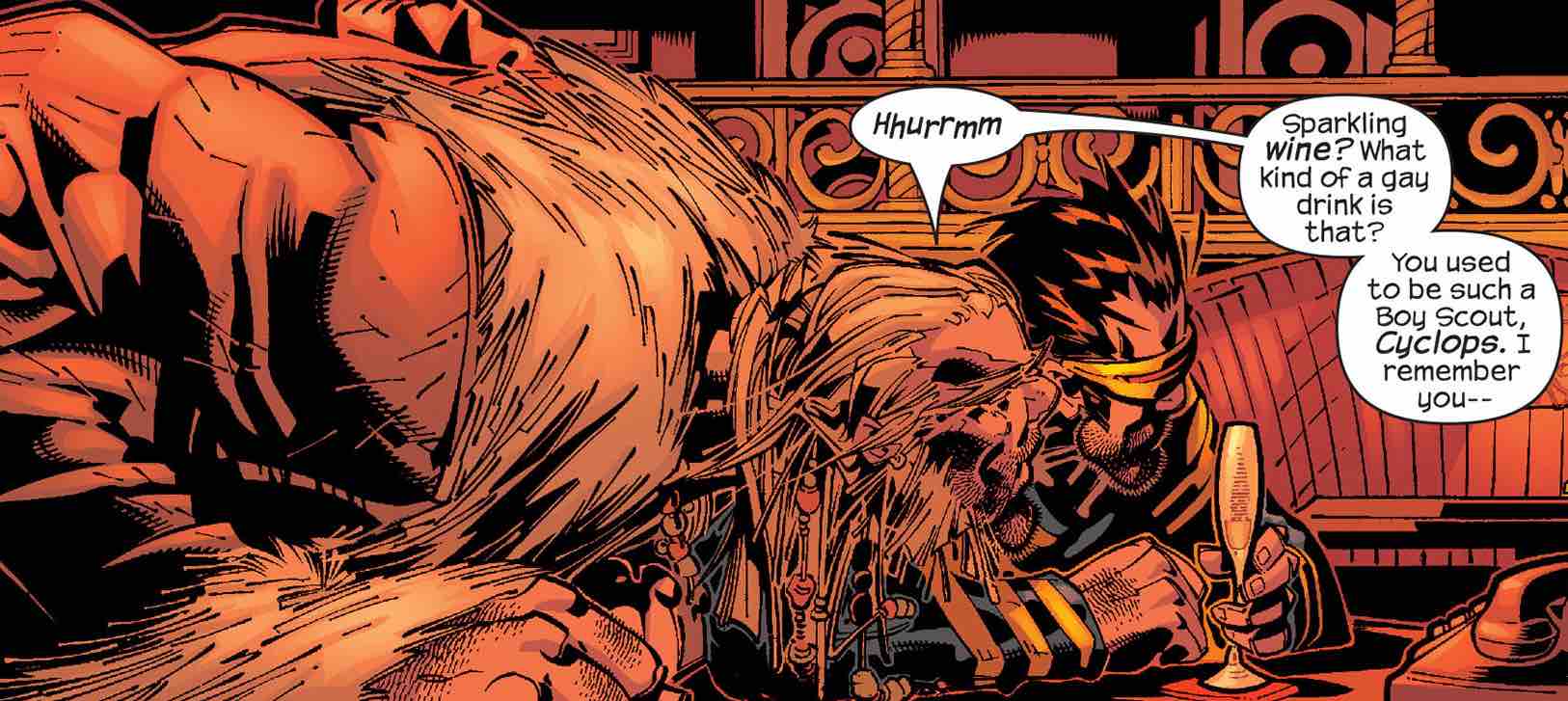
Grant Morrison, Chris Bachalo, Tim Townsend
An older, more expressly materialist and unsubtle rapist and murderer version of Quentin Quire’s drives is Sabretooth, who in his brief appearance in New X-Men, is constantly jockeying for sexually and socially dominant position which he could only possibly sustain by threat of violence and obviously affected swagger.
Trying to project dominance with a strong smell and a loud mouth, Sabertooth is the old man bark of the insecure who never had a prime to be past, measuring his penis against the person standing at the next stall in the toilets.

Grant Morrison, Chris Bachalo, Tim Townsend
Stuff
A programmable machine consciousness in a transformable body, Stuff infiltrates Xavier’s school become the suspicious boyfriend of one of the Stepford Cuckoos, ultimately revealed not merely as an asshole boyfriend, but, in default physicality, resembling a hairy asshole, an anus-faced, tendrilled amoeba.
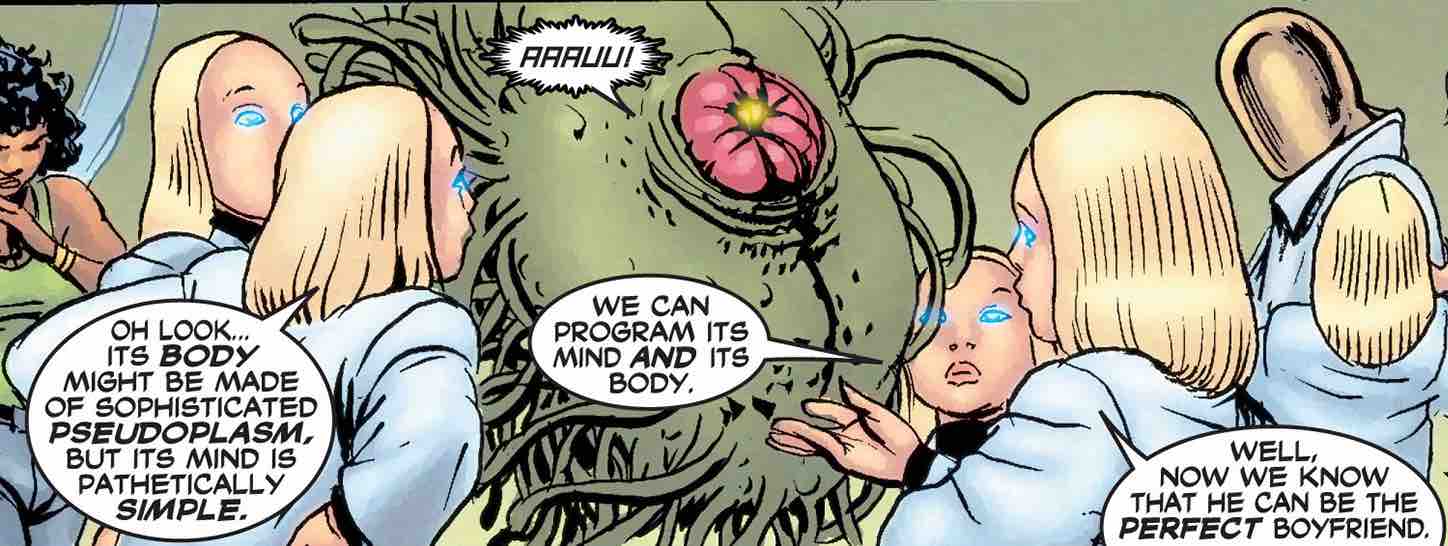
Grant Morrison, Igor Kordey, Comicraft
Stuff’s intelligence and awareness, deduced as minimal, if real at all, Stuff is repurposed as a substitute body for Cassandra Nova to occupy and in which to undergo re-education as the seeming-youth, Ernst, who will grow up to re-adopt her Cassandra name, while retaining Stuff’s aging and failing machine body.
Wolverine
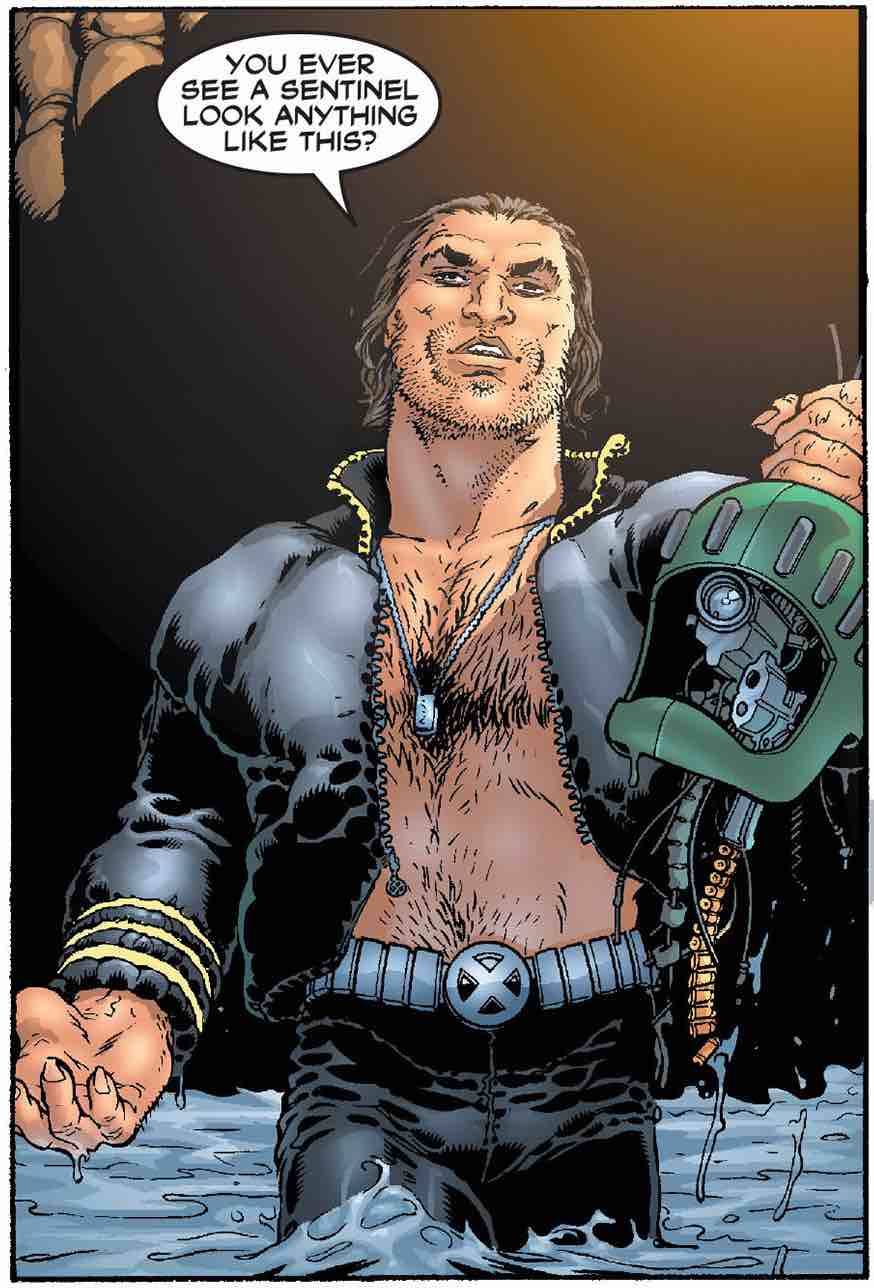
Frank Quitely, Grant Morrison, Tim Townsend
Wolverine, with his metal skeleton, amnesia, and quick healing, is a zen tomcat, but he is a tomcat who has sometimes been declawed, sometimes been fixed, sometimes being left out in the cold. He is, in New X-Men, explicitly a merger of mutant and machine aimed back at his own people, a categorization that horrifies him during Assault on Weapon Plus.
A conscious effort was made by Morrison and Frank Quitely, to enjoy some of the eroticism brought to the character by actor Hugh Jackman in the X-Men feature films, while not physically modeling the character performer.
During the serialization of New X-Men, the first canon story of Wolverine’s childhood was published, revealing he was a pampered, sickly youth, and somewhere near one hundred years old by the time of New X-Men. This early physical awareness, including the sense of being physically incapable, of early sexual awakening and loss, is turned against Wolverine by Quentin Quire, who, while high on kick, sees deeper inside minds than anyone, and with greater clarity.
It is possibly coincidental that is attack takes place during a brief moment where Wolverine experiments with a younger, hipper look, but if so, that is a beautiful coincidence.

Grant Morrison, Frank Quitely, Avalon Studios
There remains a persistent rumor that Morrison intended the “three in a bed” adventure of Wolverine, Cyclops, and Fantomex, to begin, after a hard night of drinking, literally three in a bed. Morrison’s Wolverine radiates sexual energy.
New X-Men‘s Wolverine seems to subconsciously frame his sexual expression casually and with ease, pursuing and accepting both one-off sexual engagements and lengthier romantic relationships. Eagerly having sex with Domino after a mission, he also rejects a pass from the married Jean Grey.
The Stepford Cuckoos

Igor Kordey, Hi Fi, Grant Morrison
Stuff is a wolf in a chicken suit, and the Stepford Cuckoos are figuratively, both Stepford Wives and (Midwich) Cuckoos. A set of identical siblings with a hive mind, counted differently psychic mutants and non-psychic (who often count one less), they are engineered by the Weapon Plus program, and they are hiding, to be raised, as mutants in the Xavier Institute.
Rapidly physically maturing during the run of New X-Men, the Cuckoos are explicitly children in a way they will be treated and no other comic, and are here afforded a lack of upskirt artwork or porno-ized private schoolgirl motifs.
Their surface resemblance to their mentor, Emma Frost, meaning, specifically, she is a bottle blonde and they have blonde hair, is transfigured in later comics, by other artists and writers, into them being clones of Frost, but in the context of New X-Men, they are simply blonde, psychic powers, and Emma is a teacher who pays special attention to them.
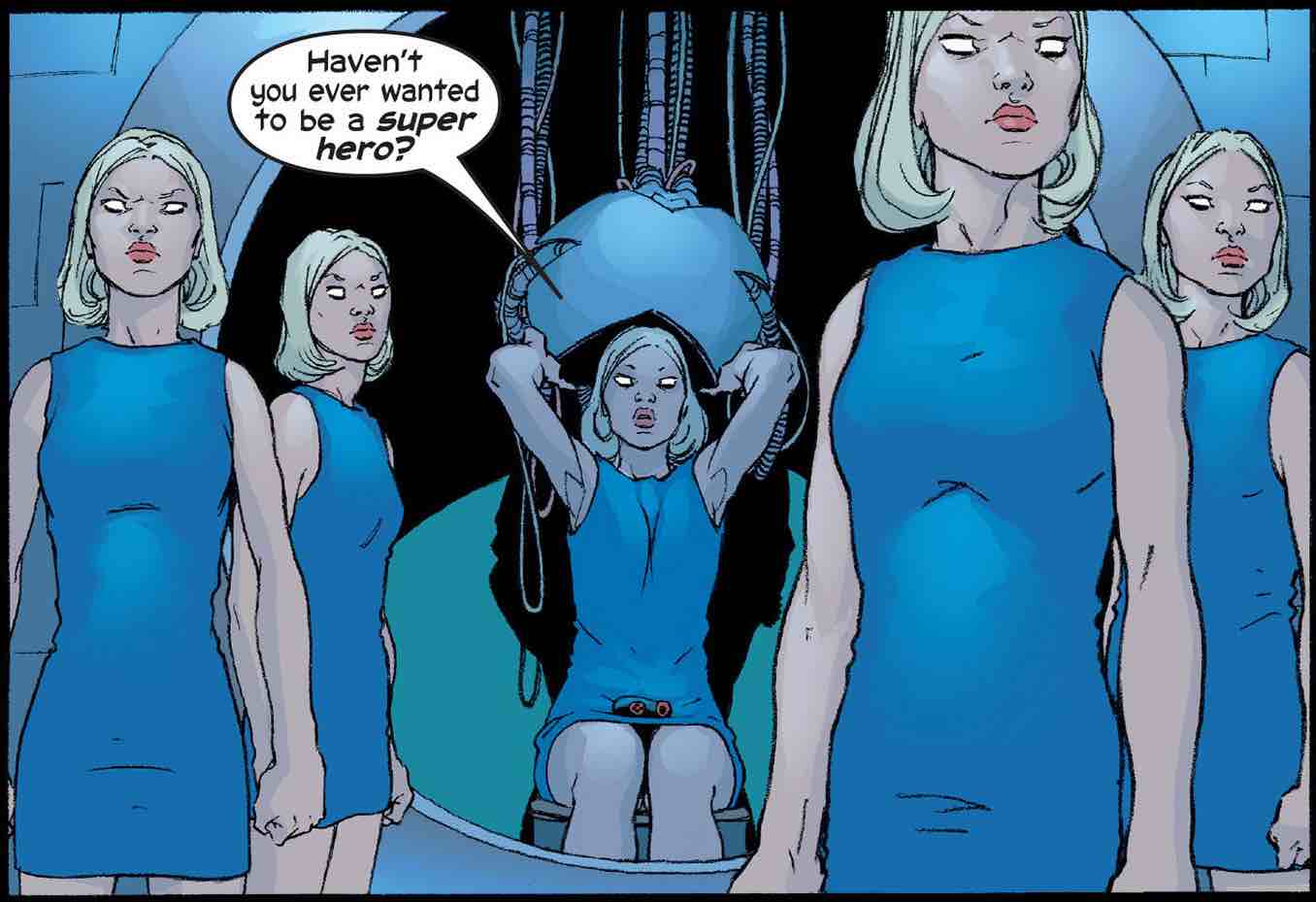
Grant Morrison, Frank Quitely, Avalon Studios
The hive aspect of their minds does not imply a uniform mind, a demonstrated by their individual urges and private thoughts, but they share more than traditional family or human beings. One maybe attracted to a Japanese exchange students, another to a drug-dealing world-conquering old man. With effort they can compartmentalize, but they also draw strength deliberating their emotions and concerns amidst the hive.
EVA/Fantomex

Grant Morrison, Dave McCaig, Igor Kordey
Weapon XIII, who identify as Fantomex and EVA, like the Cuckoos are product of the Weapon Plus program, and like the Cuckoos (and Weapon XII, the Huntsman), they are a multiple-body, multiple-mind person. A two-body person with multiple brains running in tandem, the Fantomex body comprises the meat and bone of the person, and EVA, the nervous system, with each sharing thoughts and perceptual systems at will.
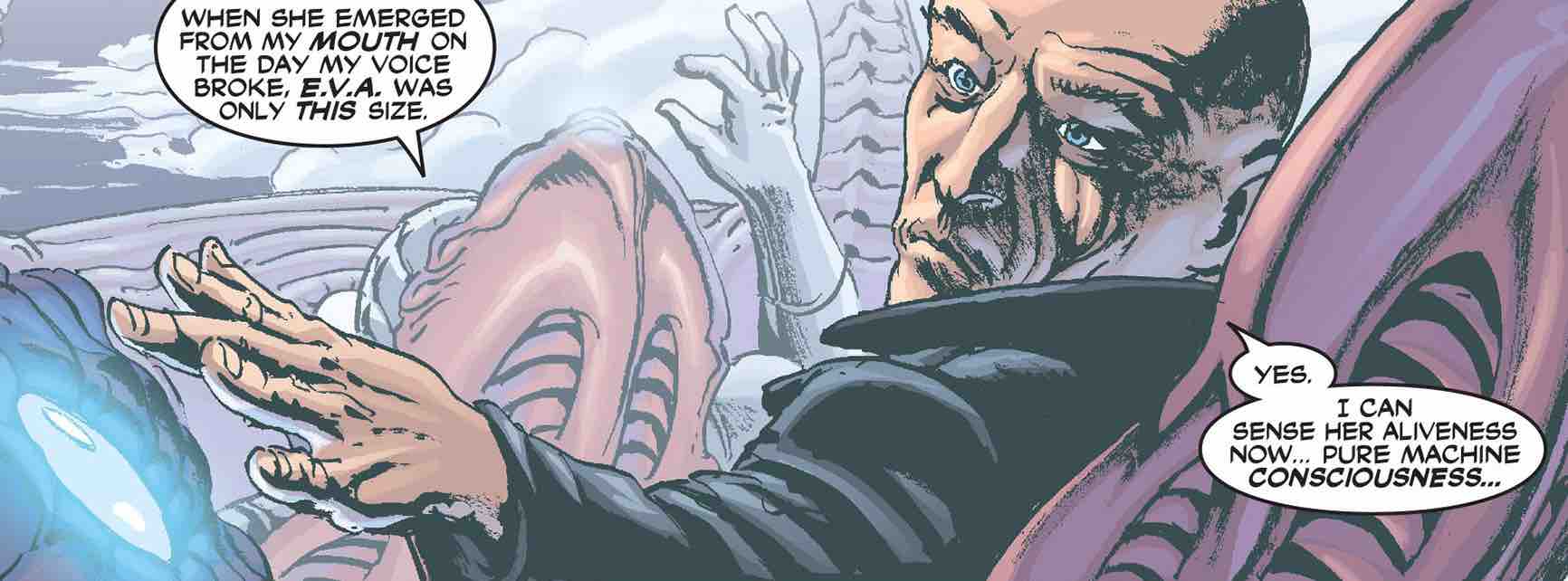
Igor Kordey, Grant Morrison, Richard Starkings

Igor Kordey, Grant Morrison, Richard Starkings
Fantomex/EVA are a smart kid in bodies that look like a grown adult and an insectile or vegetal flying saucer. They disguise their unified nature by playing off Fantomex’s lack of internal pain receptors or his overheating head as a tough guy facade and being a little bit eccentric and dumping ice water or orange juice over his head. They downplay EVA as a vehicle or outgrowth, a kind of pet or girlfriend, rather than an active, mature participant, shielding the risk to both of them that her being the pain receptors and other sensorial aspects, as well as the dominant physical control for both bodies otherwise presents.
Bisexual or pansexual, Fantomex flirts with men and women, but true to his less-than-secure and less-experienced-than-advertised true nature, he does not, in New X-Men, actually have sex or sexual relations with anyone.

Chris Bachalo, Grant Morrison, Chris Chuckry
It is EVA, who can see, feel, and is the primary sensorial organ, with her “pure” machine consciousness, who Jean Grey reaches out to physically and emotionally with admiration, much as Tom Skylark will in the 150-years-from-now future of Here Comes Tomorrow.

Marc Silvestri, Grant Morrison, Billy Tan
Fantomex may be blind, or at times blind, lacking an internal nervous system and being often portrayed with extremely dilated eyes giving a fifty-six yard stare.
Aside from the allusion to comics character, Eva Kant, Eva’s name implies the acronym for Extravehicular Activity, meaning actions performed outside Earth’s atmosphere by cosmonaut or astronaut outside of a spacefaring vessel. Fantomex is, by implication, the vehicle or vessel, and indeed, EVA did leave Fantomex’s body in order to perform her operations.
EVA, despite her lack of anthropomorphism (until the future), is the cosmonaut, working outside the pseudo-Earth laboratory they were raised in, called the World.
Apollyon
The Destroyer, Apollyon, might be Fantomex in the future, cut loose from EVA, and he might be just some guy. Apollyon, in the end, is a lot of guys, a lot of just some guys, who feel they are missing a completion another person or an infusing of company and power could provide. An extreme reaction to loneliness, spurred by jealousy add an inflated sense of self-significance, this perceived deprivation results in a user mentality and then abusive, dehumanizing ethos, correlating cleanly to the U-Men organization, as well as the ugliest jealousy and grumbling of many other New X-Men characters, including Cyclops, Sabretooth, Quentin Quire and John Sublime.
In Here Comes Tomorrow, Apollyon is willing to condemn the entire population of Earth for the promise of grafts of the Phoenix, a thing that may or may not even be possible.
Glob Herman
Allegories for the trade of bodily capacity for capital pervade New X-Men, including Glob Herman becoming Quire’s right hand, once Quire realizes they can squeeze off Glob’s outer, parafin-esque layers, and light it on fire, making him a big, eager candle, or, as he puts it, “the Inhuman Torch!”
Angel
Angel Salvadore, who’s ethnicity and parentage is deliberately open for debate, finds self-worth and self-loathing in the fly-like wings that correspond puberty.

Igor Kordey, Grant Morrison, Hi Fi
Salvadore navigates the global microcosm of the Xavier Institute by embracing cultural stereotypes, pop movie tropes, and capitalist exchanges that here to give her some autonomy and control, including, on a bet, kissing her classmate, Beak, who instantly falls in love with her.
She brags about drugs she has never taken to students who ultimately are at that time drug dealers at the school. Excited by Beak’s insecurity being greater than her own, his body issues more intense than her own (he looks like a human chicken, lightly feathered and with a prominent beak) she embraces and eventual romantic relationship with him.
She revels in the volatile an undeniably biologic aspects of her insect-like superpowers, including vomiting corrosive acid.
When Salvadore becomes pregnant, she and Beak produce a brood of eggs, several of which hatch bird-insect hybrid babies, whom the parents name after the Jackson Five.

Grant Morrison, Phil Jimenez, Andy Lanning
Beak
The father of Salvadore’s children, Beak had a condom on him the night she became pregnant, meaning one of two things occurred: a) they had sex on their camping trip, prior to being attacked by U-Men and did not use the condom, which beak later applies to another classmate in an attempt to save their life, or b) having used to be condom as emergency first aid, Beak and Angel Salvadore have sex the next day, after the school riot and the prize-giving ceremony.
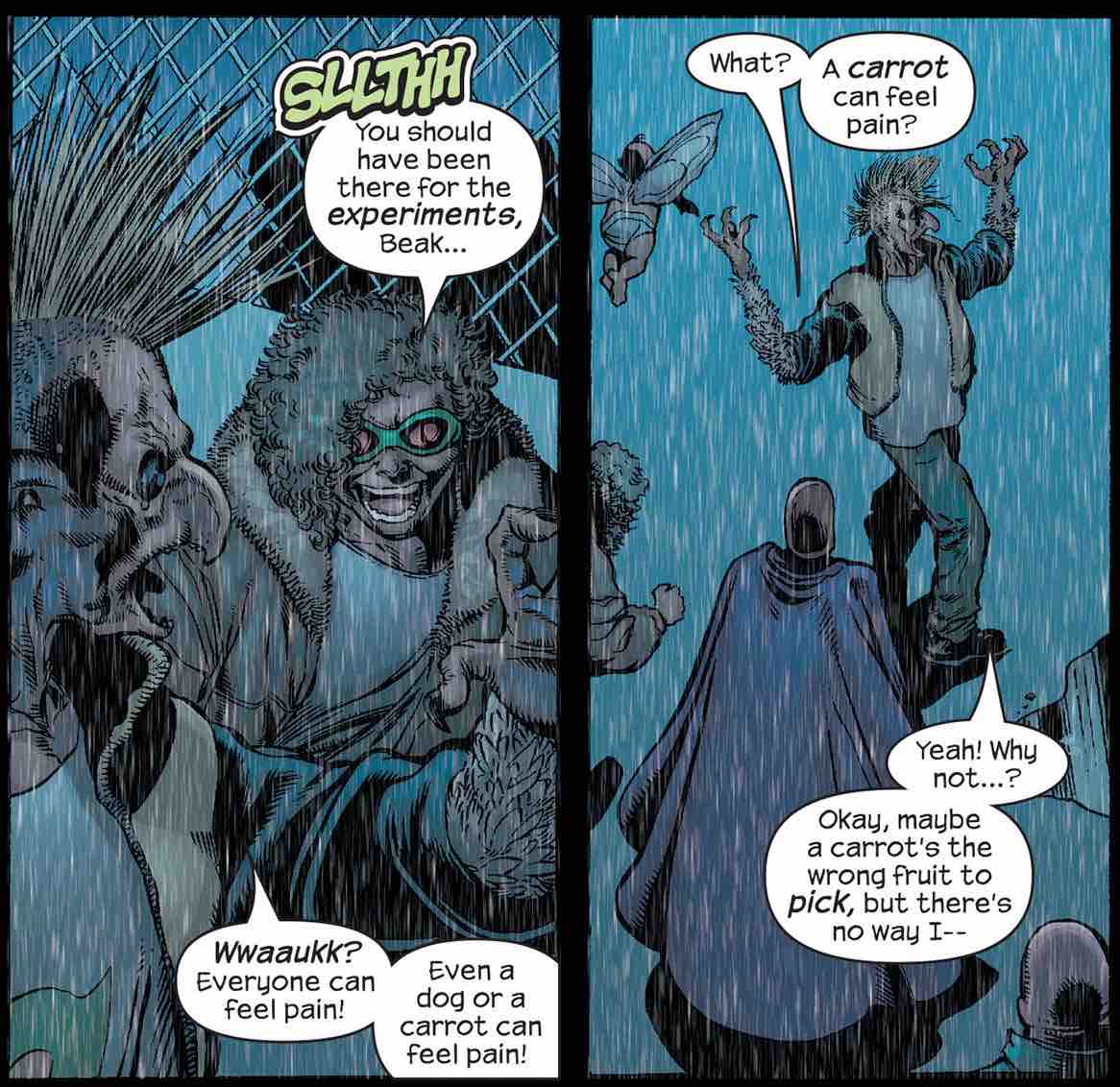
Phil Jimenez, Andy Lanning, Grant Morrison
In either case, Salvadore produced the eggs by the next morning, and they were parents less than seventy-two hours from conception.
No Girl
Martha Johansson has her brain cut out of her body and preserved alive, drug-addicted, to be manipulated, first by John Sublime, and then by Magneto. A teenage runaway, Johansson has to handle an incredibly tough age without limbs, a torso, or a face.
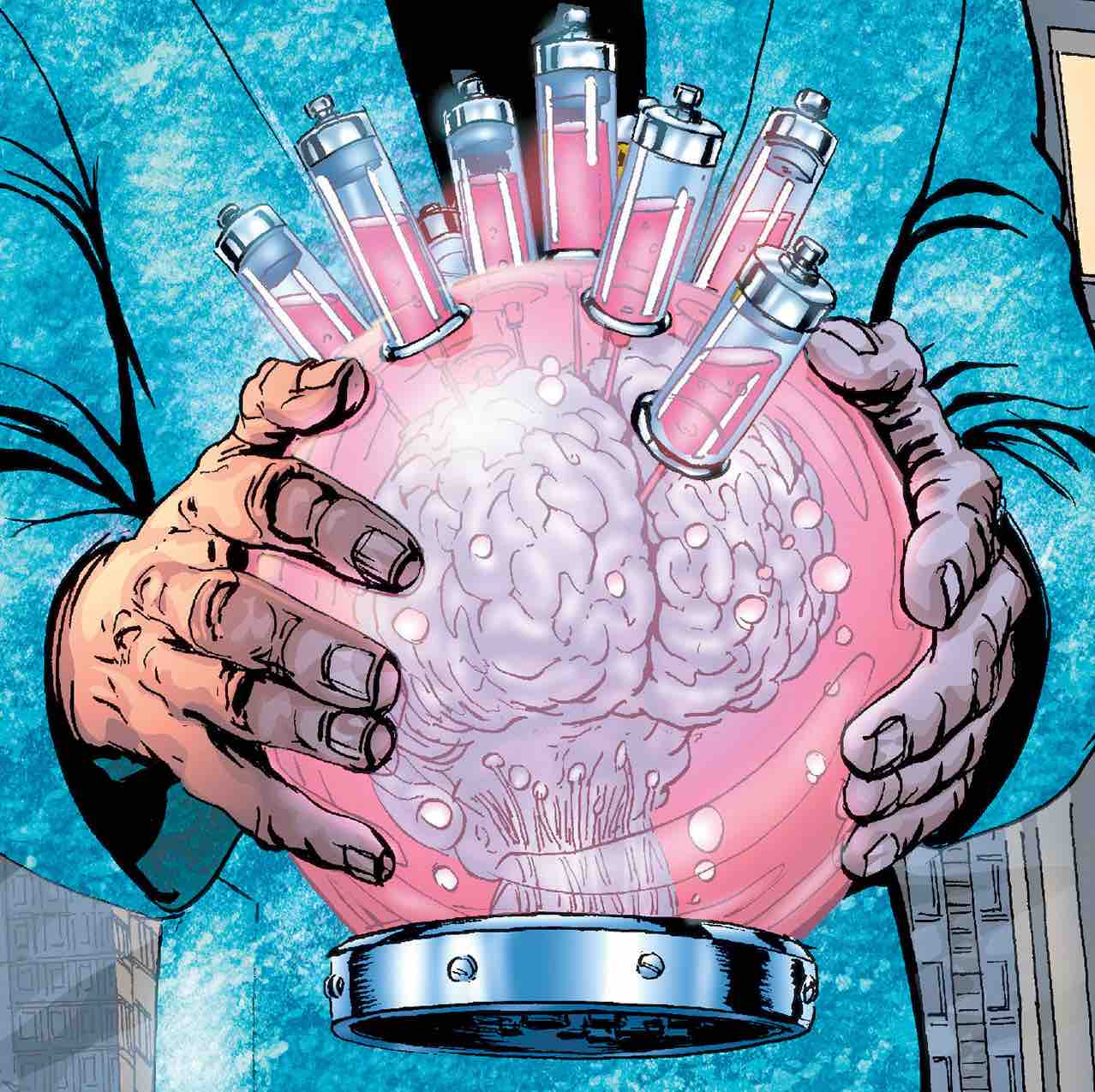
Grant Morrison, Igor Kordey, Hi Fi
Quentin Quire develops an anti-gravity suspension device to give her greater mobility and allow her brain to be suspended at a normative eye level with her classmates and fellow students, but she achieves greater mobility and comfort in her disembodied, pretend-body cartoon identity as No Girl.
No Girl is not about a physical need or a personal lack, but confidence-building. Social involvement. No Girl does not exist by Johansson alone, but through socialization.
It takes Xorn, a disguised Magneto, an entire day and night to understand No Girl, to share in Johansson’s vivid imaginary, interpretive world, but even a cranky, spiteful, regressive man can eventually savvy.
At the time of her death, her best friend, Cassandra Nova, praises her “cartoon world,” and laments that they were never truly appreciated as a great duo.
Friends for over one hundred years, both incredible psychic talents, each equally biological and machine, Ernst and No Girl are made by the people around them. Social beings, they live long, influential lives, healthily understanding from an early age that most of who you are is what you try to be and what you make up.





